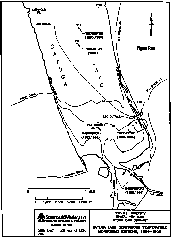
The Lake Source Cooling Project
Cornell's proposed 55 million dollar Lake Source Cooling Project
would be financed by tax-exempt, municipal bonds. Cold water
(41 F) would be pumped from a depth of 250 feet near the bottom of Cayuga Lake
and piped more than two miles to a heat exchange facility located near the
southern terminus of the lake. The cold lake water, which is
phosphorus-rich, would pass continuously through heat exchangers, absorbing
heat from a five-mile circulating loop that would send chilled water to the
campus and return warmed water to be re-chilled. This heat exchange would
raise the lake water temperature as much as 15
F) would be pumped from a depth of 250 feet near the bottom of Cayuga Lake
and piped more than two miles to a heat exchange facility located near the
southern terminus of the lake. The cold lake water, which is
phosphorus-rich, would pass continuously through heat exchangers, absorbing
heat from a five-mile circulating loop that would send chilled water to the
campus and return warmed water to be re-chilled. This heat exchange would
raise the lake water temperature as much as 15 F.
F.
 After passing through heat exchangers, the warmed, phosphorus-rich
lake water would not be returned to the deep portion of the lake where it
originated. Instead, it would continuously discharge into the shallow,
southern portion of Cayuga Lake through a four foot diameter pipe
stretching 500 feet into the lake where the water is nine to 12 feet deep. Ambient
levels of total phosphorus reportedly monitored near the proposed Lake
Source Cooling discharge as well as in the vicinity of the intake exceed
New York State guidance values.6
The new discharge is expected to increase
phosphorus loading by an estimated four to seven percent.
After passing through heat exchangers, the warmed, phosphorus-rich
lake water would not be returned to the deep portion of the lake where it
originated. Instead, it would continuously discharge into the shallow,
southern portion of Cayuga Lake through a four foot diameter pipe
stretching 500 feet into the lake where the water is nine to 12 feet deep. Ambient
levels of total phosphorus reportedly monitored near the proposed Lake
Source Cooling discharge as well as in the vicinity of the intake exceed
New York State guidance values.6
The new discharge is expected to increase
phosphorus loading by an estimated four to seven percent.
Prepared by the
Cayuga Lake Defense Fund (CLDF).
For more information, Call: 275-9054 or 272-7914
or email
info@cldf.org
CLDF 1998
 F) would be pumped from a depth of 250 feet near the bottom of Cayuga Lake
and piped more than two miles to a heat exchange facility located near the
southern terminus of the lake. The cold lake water, which is
phosphorus-rich, would pass continuously through heat exchangers, absorbing
heat from a five-mile circulating loop that would send chilled water to the
campus and return warmed water to be re-chilled. This heat exchange would
raise the lake water temperature as much as 15
F) would be pumped from a depth of 250 feet near the bottom of Cayuga Lake
and piped more than two miles to a heat exchange facility located near the
southern terminus of the lake. The cold lake water, which is
phosphorus-rich, would pass continuously through heat exchangers, absorbing
heat from a five-mile circulating loop that would send chilled water to the
campus and return warmed water to be re-chilled. This heat exchange would
raise the lake water temperature as much as 15 F.
F.

 After passing through heat exchangers, the warmed, phosphorus-rich
lake water would not be returned to the deep portion of the lake where it
originated. Instead, it would continuously discharge into the shallow,
southern portion of Cayuga Lake through a four foot diameter pipe
stretching 500 feet into the lake where the water is nine to 12 feet deep. Ambient
levels of total phosphorus reportedly monitored near the proposed Lake
Source Cooling discharge as well as in the vicinity of the intake exceed
New York State guidance values.
After passing through heat exchangers, the warmed, phosphorus-rich
lake water would not be returned to the deep portion of the lake where it
originated. Instead, it would continuously discharge into the shallow,
southern portion of Cayuga Lake through a four foot diameter pipe
stretching 500 feet into the lake where the water is nine to 12 feet deep. Ambient
levels of total phosphorus reportedly monitored near the proposed Lake
Source Cooling discharge as well as in the vicinity of the intake exceed
New York State guidance values.